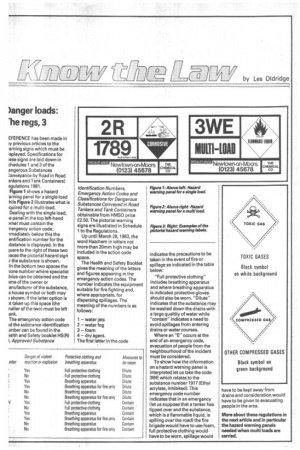)anger loads: he regs, 3
Page 63

If you've noticed an error in this article please click here to report it so we can fix it.
EFERENCE has been made in ly previous articles to the 'arning signs which must be isplayed. Specifications for iese signs are laid down in chedules 1 and 3 of the angerous Substances :onveyance by Road in Road ankers and Tank Containers) egulations 1981.
Figure 1 shows a hazard .arning panel for a single load bile Figure 2 illustrates what is Iquired for a multi-load. Dealing with the single load, le panel in the top left-hand 'mei must contain the nergency action code; imediately below this the entification number for the ibstance is displayed. In the juare to the right of these two )aces the pictorial hazard sign it the substance is shown. In the bottom two spaces the lone number where specialist Nice can be obtained and the line of the owner or anufacturer of the substance, s house symbol or both may a shown. If the latter option is )t taken up this space (the nailer of the two) must be left ank.
The emergency action code )d the substance identification imber can be found in the 3alth and Safety booklet HS(R) I, Approved Substance
Identification Numbers, Emergency Action Codes and Classifications for Dangerous Substances Conveyed in Road Tankers and Tank Containers obtainable from HMSO price £2.50. The pictorial warning signs are illustrated in Schedule 1 to the Regulations.
Up until March 28, 1983, the word Hazchem in letters not more than 20mm high may be included in the action code space.
The Health and Safety Booklet gives the meaning of the letters and figures appearing in the emergency action codes. The number indicates the equipment suitable for fire fighting and, where appropriate, for dispersing spillages. The meaning of the numbers is as follows: 1 — water jets 2— water fog 3— foam 4 — dry agent. The first letter in the code indicates the precautions to be taken in the event of fire or spillage as indicated in the table below: "Full protective clothing" includes breathing apparatus and where breathing apparatus is indicated protective gloves should also be worn. "Dilute" indicates that the substance may be washed down the drains with a large qualtity of water while "contain" indicates a need to avoid spillages from entering drains or water courses.
Where an "E" occurs at the end of an emergency code, evacuation of people from the neighbourhood of the incident must be considered.
To show how the information on a hazard warning panel is interpreted let us take the code 3WE which relates to the substance number 1917 (Ethyl acrylate, inhibited). This emergency code number indicates that in an emergency (let us suppose that a tanker has tipped over and the substance, which is a flammable liquid, is spilling over the road) the fire brigade would have to use foam, full protective clothing would have to be worn, spillage would have to be kept away from drains and consideration would have to be given to evacuating people in the area.
More about these regulations in the next article and in particular the hazard warning panels needed when multi loads are carried.


































































